

Weather Wiz Kids weather information for kids. JetStream - An Online School for Weather. Ice continued to cling to the Great Lakes in mid-March, 2014.
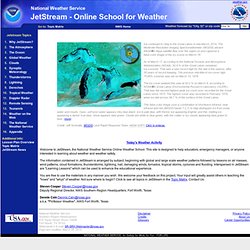
The Moderate Resolution Imaging Spectroradiometer (MODIS) aboard NASAs Aqua satellite flew over the region on and captured a false-color image of the icy scene on March 18. As of March 17, according to the National Oceanic and Atmospheric Administration (NOAA), 82.8 % of the Great Lakes remained ice-covered. That sets a new record high for this late in the season, after 35 years of record keeping.
The previous mid-March ice cover high, 75.85% covered, was set on March 15, 1978. The ice cover peaked this year at 92.2 % on March 6, according to NOAAs Great Lakes Environmental Research Laboratory (GLERL). This false-color image uses a combination of shortwave infrared, near infrared and red (MODIS bands 7,2,1) to help distinguish ice from snow, water and clouds. Credit: Jeff Schmaltz, MODIS Land Rapid Response Team, NASA GSFC Click to enlarge.
Education Resources: Science Olympiad Resources Collection. NSTA Learning Center. Description Science Objects are two hour on-line interactive inquiry-based content modules that help teachers better understand the science content they teach.
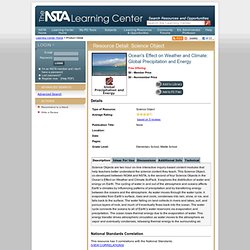
This Science Object, co-developed between NOAA and NSTA, is the second of four Science Objects in the Ocean’s Effect on Weather and Climate SciPack. Hurricane Katrina: A Problem-Based Learning Module. To What Degree? - What Science Is Telling Us About Climate Change. Precipitation Education. Rain EnGAUGE Celebrate the launch of the Global Precipitation Measurement (GPM) Mission by hosting a GPM Rain EnGAUGE Event – a family science night at your school, outdoor education center, library or museum.
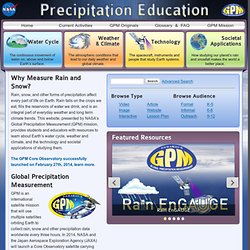
Visit this page for a full electronic toolkit, including activities menu, planning schedules, a sample advertising flier, and more. Visitor Center Launch Party If you live in the Maryland / Washington DC area, come to the NASA Goddard Visitor center on Feb. 27th to help celebrate the launch of GPM with students, families, and NASA scientists. Faces of GPM Learn about the exciting and diverse team that works with the GPM mission. GPM Original Resources. Assignment Discovery: Hurricane Tracking Methods" Fronts: the boundaries between air masses. World Climate: Weather rainfall and temperature data. Climate And Energy Lesson Plans. World Climates. Some facts about climate The sun's rays hit the equator at a direct angle between 23 ° N and 23 ° S latitude.
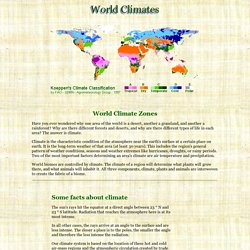
Radiation that reaches the atmosphere here is at its most intense. In all other cases, the rays arrive at an angle to the surface and are less intense. The closer a place is to the poles, the smaller the angle and therefore the less intense the radiation. Our climate system is based on the location of these hot and cold air-mass regions and the atmospheric circulation created by trade winds and westerlies. Volcanoes, Earthquakes, Hurricanes, TornadoesForces of Nature: Science, Maps, Photos, Video (National Geographic)
Create-a-Cane. Understanding Meteorology and the Atmosphere: In Depth Lessons on Weather Forecasting. The atmosphere of earth is the protective layer that sustains life and produces all the weather you see.
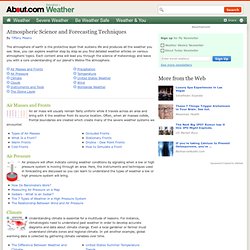
Now, you can explore weather step by step as you find detailed weather articles on various atmospheric topics. Each content area will lead you through the science of meteorology and leave you with a core understanding of our planet's lifeline-The atmosphere. Air Masses and Fronts An air mass will usually remain fairly uniform while it travels across an area and bring with it the weather from its source location. Often, when air masses collide, frontal boundaries are created which create many of the severe weather systems we encounter. Air Pressure Air pressure will often indicate coming weather conditions by signaling when a low or high pressure system is moving through an area.
Climate Understanding climate is essential for a multitude of reasons. Clouds Clouds are familiar to all of us. Instruments and Tools. A Student's Guide to Global Climate Change. Our world is always changing.

Look out your window long enough, and you might see the weather change. Look even longer, and you'll see the seasons change. The Earth's climate is changing, too, but in ways that you can't easily see. The Earth is getting warmer because people are adding heat-trapping gases to the atmosphere, mainly by burning fossil fuels. These gases are called greenhouse gases.
Thunderstorms Lesson Plans. Knowledge Net. Ready for a Storm Invite student to talk about the kinds of storms they have been in.
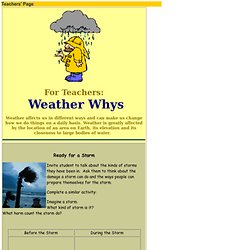
Ask them to think about the damage a storm can do and the ways people can prepare themselves for the storm. Complete a similar activity: Imagine a storm. What kind of storm is it? The Carbon Cycle Game.